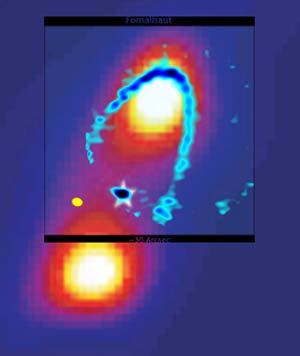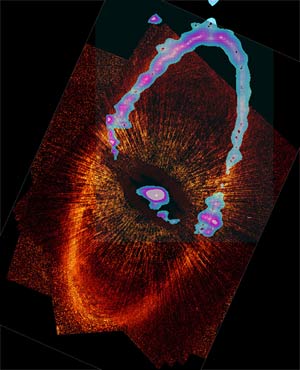Astronomers have released the first new science results from the Atacama Large Millimeter/submillimeter Array (ALMA), a still-under-construction network of 66 antennas in northern Chile. The new observations suggest the contentious Fomalhaut star system may have two small planets shepherding its gigantic ring.

This image shows the remarkable improvement ALMA heralds in radio wavelength observations. In 2003, Fomalhaut's dust ring appeared as two bright blobs (red-yellow) in observations using the James Clerk Maxwell Telescope's Submillimeter Common-User Bolometer Array (SCUBA). The inset shows ALMA data (blue) of one side of the same disk. The star hides behind the dot in the middle.
SCUBA: Holland et al. / ApJ 2003; ALMA: Boley et al. / ApJL 2012
The first new science results are out from the Atacama Large Millimeter/submillimeter Array (ALMA) in Chile, and they’re worth bragging about. The observations reveal the debris ring around the star Fomalhaut in exceptional detail, as shown in the comparison image at right, which overlays the ALMA data on top of observations at a similar wavelength taken in 2003. (The blobs are the ring, 2003-style.)
Only 15 of the planned 66 antennas contributed to the new observations, but when considered along with the first test images released last fall, the new data are enough to confirm ALMA should live up to the extraordinary expectations set for it.
“It’s as if you’re witnessing the type of breakthrough image first provided by the Hubble Space Telescope,” says Paul Kalas (University of California, Berkeley), who has used that telescope to study the Fomalhaut system before.
“It’s really an amazing instrument,” agrees Aaron Boley (University of Florida), principle investigator on the new study, which will appear in the Astrophysical Journal Letters. Part of that amazingness is ALMA’s superb resolution and sensitivity, unprecedented even in the modern astronomy era. But part of it, too, is the effort ALMA staff invest working with astronomers and their data to make sure the observations are as well-calibrated as possible, ready for analysis. “It’s a user-friendly interferometer,” Boley says, “which is actually a very odd statement.”

Both the Hubble Space Telescope and ALMA reveal the sharp edges of Fomalhaut's debris disk, shown here in a composite HST-ALMA image. ALMA looked at grains that are about 1 mm wide, which are mostly influenced by gravity; HST looked at grains about 100th the size, which can be blown away by the star's radiation. The star is blocked out in the middle. Click on the image to see the proposed Fom b planet.
HST: NASA, ESA, P. Kalas, J. Graham, E. Chiang, E. Kite (University of California, Berkeley), M. Clampin (NASA GSFC), M. Fitzgerald (LLNL), and K. Stapelfeldt and J. Krist (NASA JPL); ALMA: Boley et al. / ApJL 2012
The Fomalhaut disk Boley’s team observed is a prime target for understanding planet formation. At 25 light-years away and about 20 times the Sun’s luminosity, the star is an easy, bright target that has received lots of attention. Much of that focus centers on a proposed planet, Fomalhaut b, announced by Kalas and his colleagues in 2008 using visible light images from the Hubble Space Telescope that revealed a moving spot just inside the star’s icy ring. Since then Fom b’s existence has been called into question, and it’s currently in scientific limbo.
The new observations confirm the disk is offset from the star, not a perfect circle, and far-out, starting 135
astronomical units away from the star. It’s also remarkably thin compared to its size, between 13 and 19 a.u. wide. But what are really interesting are the disk’s sharp edges: the disk doesn’t peter out to either side, but cuts off rapidly, as though carved.
Boley and his team think the best explanation is that two “shepherding planets” corral the disk, much as the moons Cordelia and Ophelia herd Uranus’s epsilon ring. These exoplanets would be less than 3 Earth masses, with one lying to either side of the debris.
It’s unclear whether the inner proposed planet could be the elusive Fom b. The ALMA results suggest the radius of the inner planet’s orbit differs from Fom b’s by about 10 a.u., but that’s not based on an actual exoplanet detection. Recent infrared observations with the Spitzer Space Telescope failed to find Fom b. Disagreement persists over whether that’s because the object was actually a transient dust cloud or because reflective debris enshrouds the planet, making it bright in optical but invisible in infrared. Planned HST and ALMA observations may help unravel the puzzle, perhaps by revealing planet-caused structure in the debris disk.
 10
10









Comments
alphapsa
April 11, 2012 at 11:35 am
See also the recently published observations by Herschel:
http://sci.esa.int/science-e/www/object/index.cfm?fobjectid=50252
You must be logged in to post a comment.
Navneeth
April 12, 2012 at 2:56 am
First: Why does the ring show up as two blobs in the JCMT image? That is, why not something more uniform but less well-defined/resolved?
Second:
Disagreement persists over whether that’s because the object was actually a transient dust cloud or because debris enshrouds the planet, making it bright in optical but invisible in infrared.
Disregarding the actual observations for a minute, shouldn't it be the other way 'round? If the planet was surrounded by debris, then wouldn't it appear dark (or not appear at all) in optical while glowing brightly, from the radiation emitted by the dust grains in IR?
You must be logged in to post a comment.
Navneeth
April 12, 2012 at 2:59 am
I'm not responsible for what was a clearly-formatted comment (including a quote in italics) appearing as a single paragraph.
You must be logged in to post a comment.
Ted A. Hunt
April 14, 2012 at 9:14 pm
Hmm. Sharp edges, no shepherd planets [yet] in evidence, and the thing's gone off-axis. Perhaps Larry Niven was thinking too small. ☺
You must be logged in to post a comment.
Ted
April 14, 2012 at 9:23 pm
Clumsy fingers on a smartphone. That second l in Fomalhaut? [CTRL-X], please.
See, Navneeth? No one expects a web page to format (or edit) like MS Word. ☺
You must be logged in to post a comment.
Bruce
April 15, 2012 at 2:53 pm
Thanks Ted. Larry Niven. I couldn't who wrote the "Ringworld" novels, but seeing these images of Fomalhaut's ring definitely reminded me of them. I add to your comments the now you see 'em, now you don't "moons" made me think of ringworld engineering activities.
You must be logged in to post a comment.
Rod
April 15, 2012 at 8:47 pm
Bruce, http://exoplanet.eu/catalog.php site shows 31 exoplanets that are imaged and Fomalhaut b is listed but flagged as possible problem. The stats for these 31 imaged exoplanets are interesting. The average mass is 13.18 Jupiters, average semi-major axis = 335.49 AU. Most of the host stars listed have young H-R ages, average is 2.18E+8 years and average host star mass = 0.74 solar masses. The accretion disk model for planet formation has difficulties explaining the origin of large planets forming so far from their host stars. This sample of 31 suggests that are more large exoplanets orbiting far from their host stars.
You must be logged in to post a comment.
Bruce
April 17, 2012 at 1:33 am
Rod, I have a comment and a question. The average mass of the set of detected by direct imaging "exoplanets" being 13.18 Jupiters caught my attention. As I'm sure you know, 13 Jupiters is the treashold minimum mass for dueterium fusion to begin in the core of a brown dwarf. Therefore I think objects of this mass and up are not really planets IMO but are failed stars, so the brown dwarf label fits better. Since binary star systems are found with a great range of separations between their components, why shouldn't we expect to find the kind of cases you are commenting on?
You must be logged in to post a comment.
Rod
April 17, 2012 at 9:30 am
Bruce, I recommend you read the list of 31 objects posted at the URL provided, a number are smaller than 13 Jupiters, the threshold and exist quite far from their host stars. Concerning the origin of brown dwarfs, NASA ADS Abstract service has quite a few reports on these and it is apparent that computer models of a collapsing gas could forming a star, there is more to the story of brown dwarf formation too than this picture.
You must be logged in to post a comment.
Bruce
April 17, 2012 at 9:37 pm
Ok, Rod, I’ve looked at these 31, directly imaged exoplanets, and many do have extremely distant orbital distances, but that’s exactly what I’d expect for this detection method. If the accretion models have trouble with these systems, well there’s work to be done in deducing how they’ve come to be, because, clearly, they exist.
You must be logged in to post a comment.
You must be logged in to post a comment.